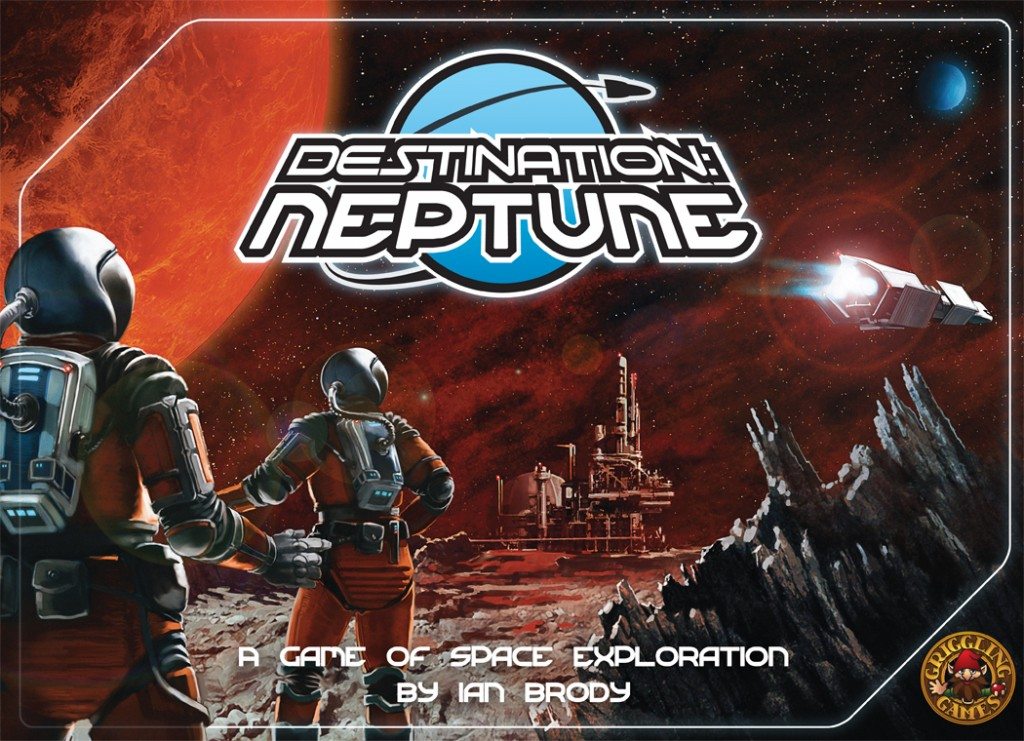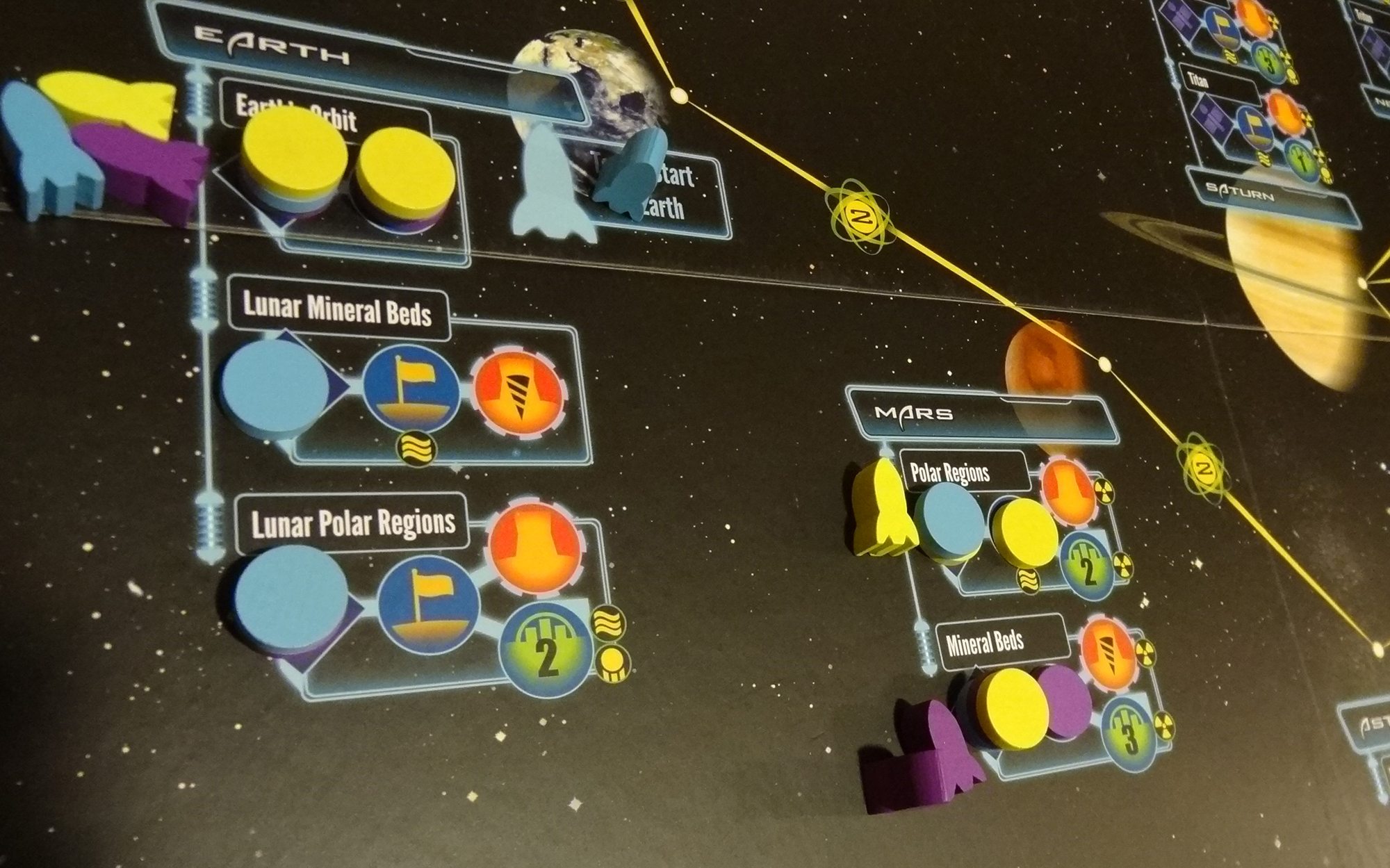The era of government-funded space exploration has given way to private industry, and commercial space exploration is booming. In Destination: Neptune from Griggling Games, you build factories and colonies on distant planets and moons over the course of four generations.
At a glance: Destination: Neptune is for 2 to 4 players, ages 12 and up, and takes about 90 minutes to play. It will be released this week (on June 11) and retails for $49.95. While there are some educational elements (for instance, a sidebar in the rulebook explaining why you’d need floating cities to colonize the gas giants), it’s really not primarily an educational game. The age range is about right—less experienced players may be able to follow the turn order but have trouble planning out a long-term strategy.

Components
- 73 basic game cards
- 12 Event cards (for optional rules)
- 19 Location cards (for optional rules)
- 12 Construction Team wooden rockets (3 each in 4 colors)
- 140 wooden disks (35 each in 4 colors)
- 56 Fuel counters
- 70 Credit counters
- 4 Fame markers
- 4 Victory Point markers
- 1 Diversification card
- 1 Intrepid Spacefarer card
- 1 game board
- 4 Player Aid cards
The board and the cardboard tokens (Fuel and Credit) are all nice and sturdy—the quad-fold board is also a nice large size and the graphics are clean and sharp. The cards are a decent quality, too. The wooden tokens are pretty standard disks, but the rocket meeples are a nice touch. One note is that the game isn’t meant to be limited to the number of counters and tokens, so if you run out you’re just supposed to find something else to substitute in. It’s probably less likely in a 4-player game, but we did run out of player tokens in a 3-player game I played.
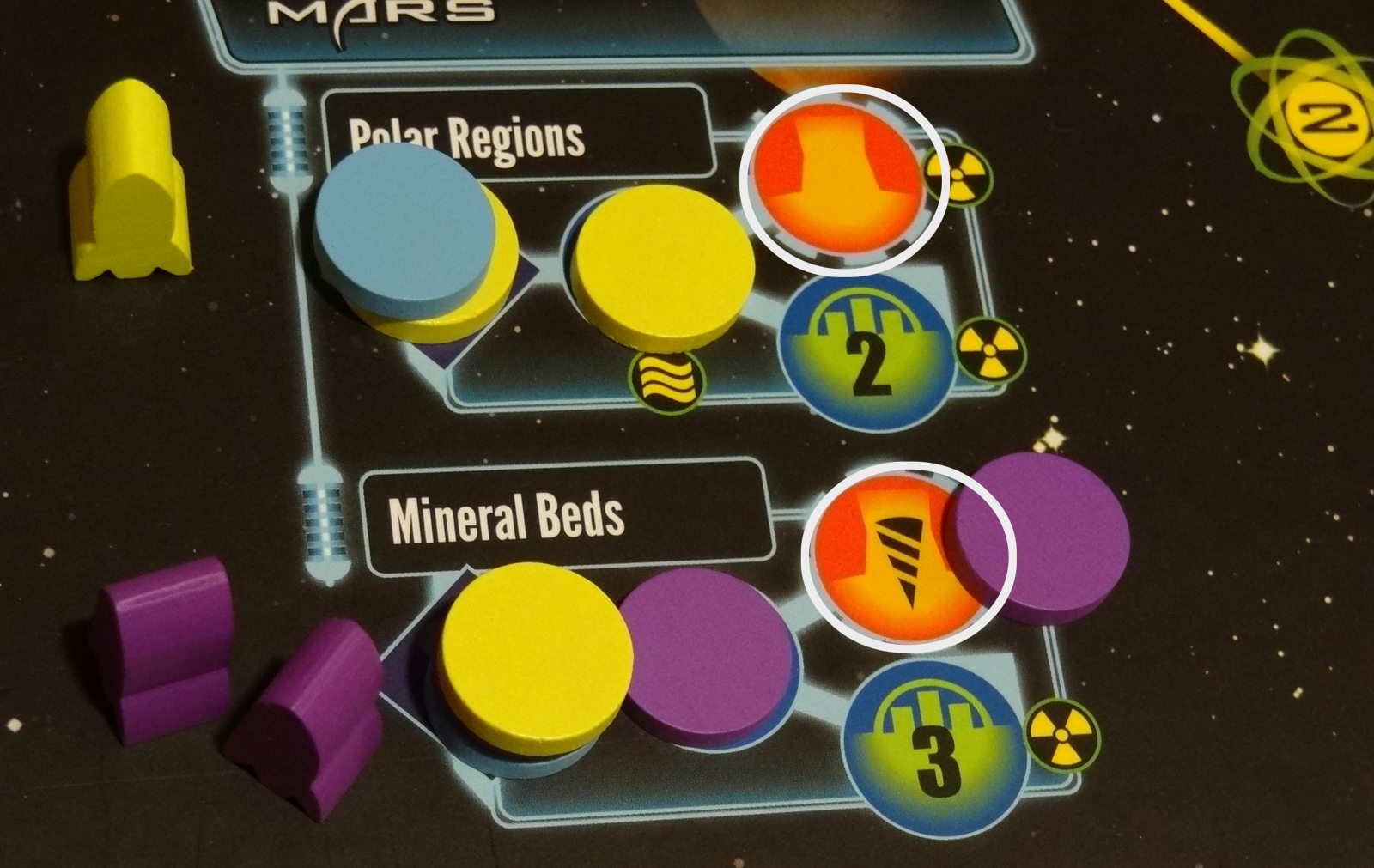
The visual design of the game is hit-or-miss. Some parts were nice—the images on the different types of cards and the look of the board itself are fine, and the icons themselves are usually pretty easy to read. But there were other parts that just didn’t seem quite as planned out. For instance, there are three different types of factories that can be built, and each offers a different combination of fuel or money when the Factories Produce card is played. However, when you build a factory, your marker covers up the icon that identifies what type of factory it is. It might have made more sense to have the building prerequisites (which show what you need to build at that location) within the circle, instead of off to the side, where they’re visible even when no longer needed.
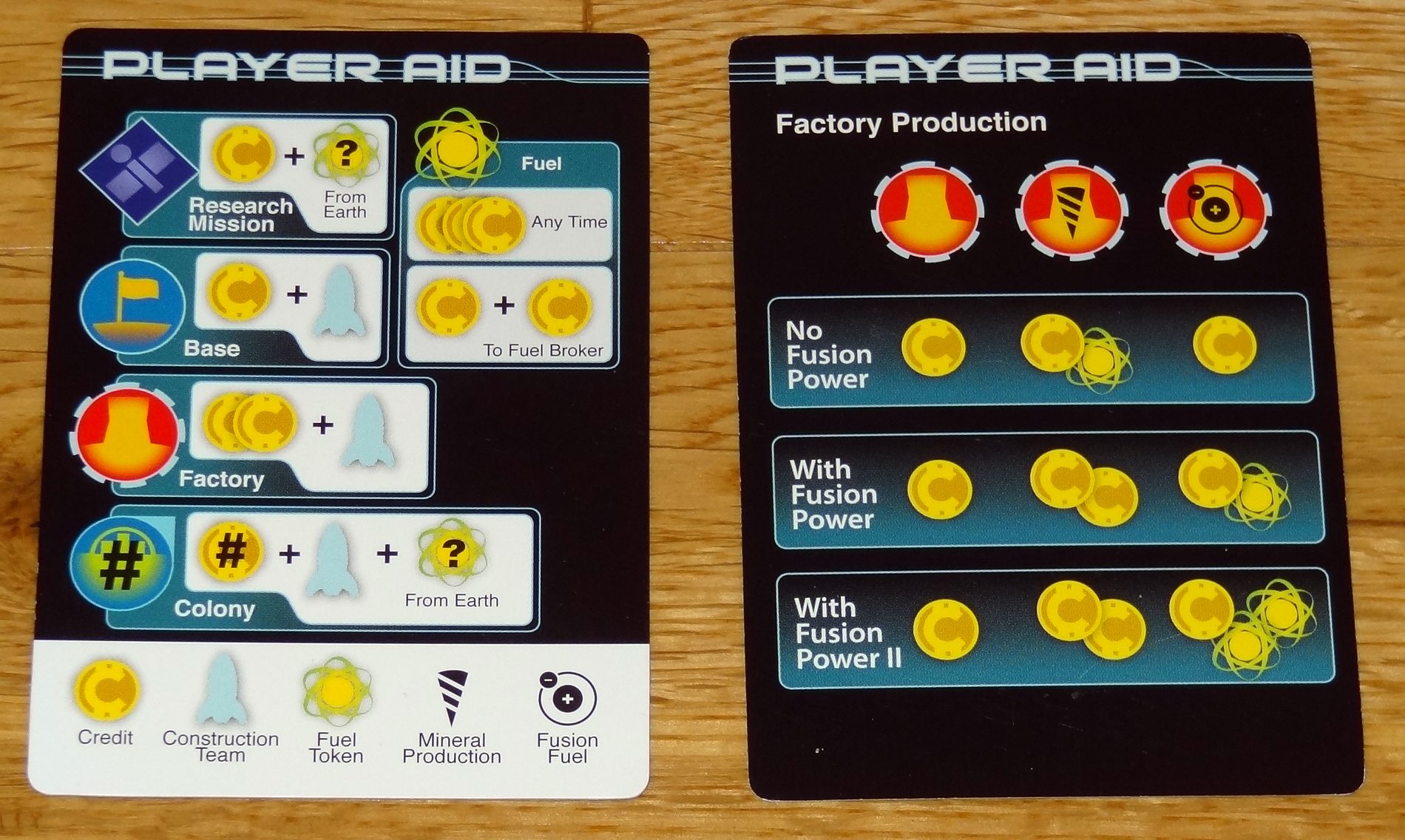
The two-sided Player Aid cards have some useful information on them, but don’t have things like explanations of the specific card types (which is given on the back of the rulebook).
The basic cards are separated into four generations, which are never shuffled together into one pile, so it would have been nice to have the backs of the cards more obviously different to make them easier to separate—and to tell which deck is which—but it’s not a huge problem.

The Event cards (used in the optional rules) are pretty boring: there are different types of events, but there’s no artwork for them, just a big exclamation point icon, which is somewhat disappointing. The Location cards are a little better: there’s artwork and a factoid telling a little more about that particular planet or location.
How to play
The rules may be downloaded here.
The goal is to have the most victory points at the end of four “generations,” which last as long as each of the four decks of cards. You get victory points by building bases, factories, and colonies, as well as founding research missions and advancing technology. There are also points for achieving fame and wealth.
The cards are separated into four decks, by generation (marked on the lower right corner of each card.) The four decks are placed next to the board in order. If you’re playing with the optional Events, then shuffle the Events and Locations separately and place those two decks near the board.
Everyone starts with 5 fuel, 5 credits, 5 cards, all of their tokens, and 5 cards from Generation 1. Each player also has three rocket ships (the construction crews) on Earth.
Your turn is pretty simple:
- You may sell a card to the Opportunity Track
- You must play a card
- Draw back up to 5 cards
The Opportunity Track consists of three face-up cards next to the board. You may place a card from your hand here, pushing all the existing cards closer to the discard pile, and you get 2 credits for doing so. If there are already three cards on the Opportunity Track, the oldest one gets discarded.
Play a card: You pick a card either from your hand or the Opportunity Track and play it. If you play a card from your hand, you immediately gain Fame as noted in the red star in the top left corner. You don’t get Fame for playing a card from the Opportunity Track.
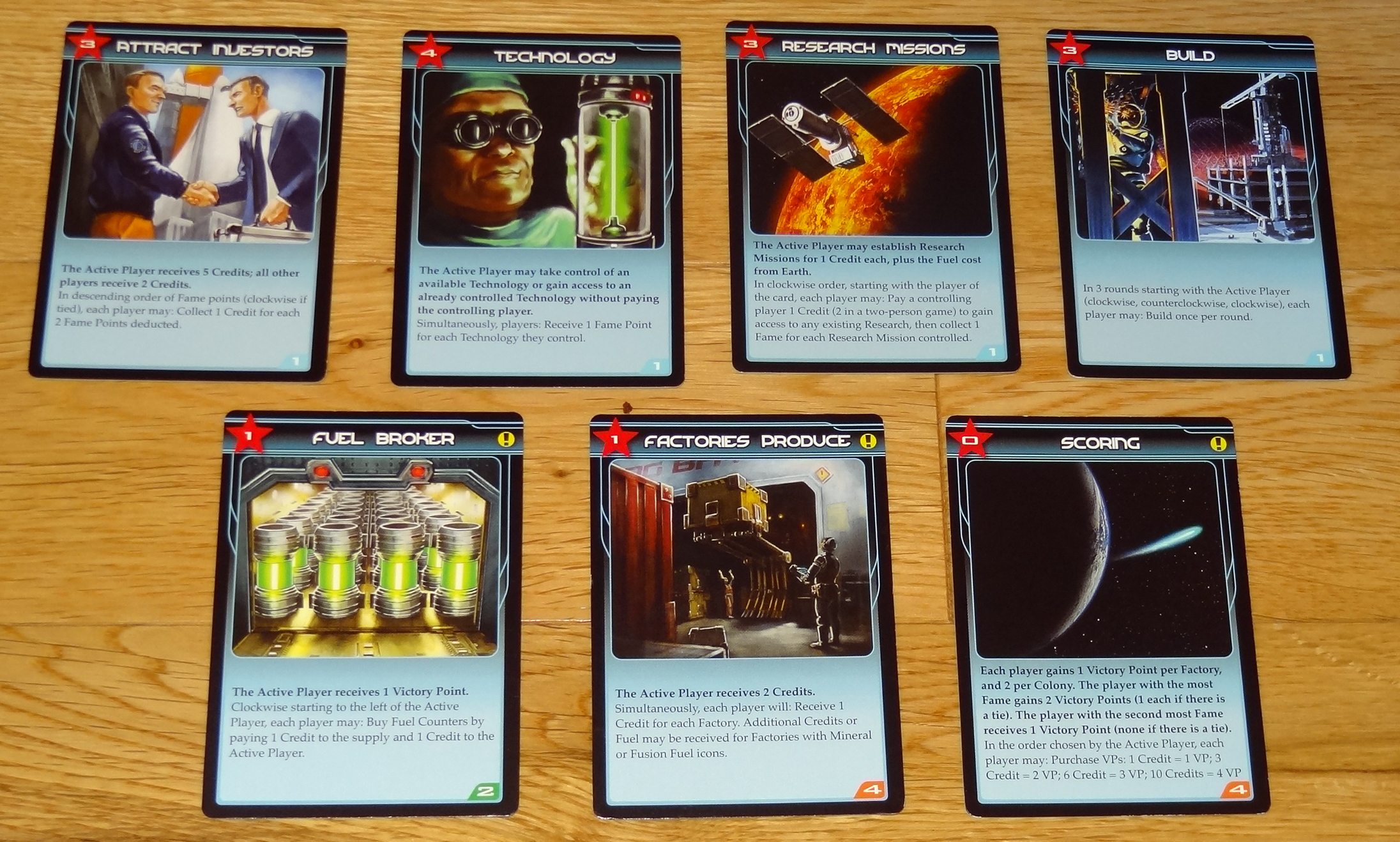
There are seven types of cards—some of them have different Fame values, particularly as you go from generation to generation. In general, each card gives a particular bonus to the person who played it, but also allows other players to take related actions or earn points.
- Attract Investors: active player gets 5 credits, everyone else gets 2, and there’s an opportunity to cash in Fame for money.
- Build: 3 rounds of building take place—more on this later.
- Factories Produce: active player gets 2 credits; players will get money and sometimes fuel for factories they own.
- Fuel Broker: active player gets 1 VP, and everyone may buy fuel at the cost of 1 credit to the bank and 1 credit to the active player. (Normally, fuel may be purchased at any time at the cost of 3 credits per fuel.)
- Research Missions: active player may establish research missions; all players may pay for access to other research missions; everyone gets 1 Fame per research mission they control.
- Technology: active player takes control of a new technology or gains access to an existing technology for free; everyone gets 1 Fame per technology they control.
- Scoring: an immediate scoring round takes place. (Scoring also happens at the end of each generation.)
Most of the actions are pretty straightforward, but some require a little more explanation. To build somewhere, you must first have access to the Research Mission for that location. In the photo below, the blue player controls the Research Missions for Lunar Mineral Beds and Lunar Polar Regions, and has access to (but doesn’t control) the Research Mission for Earth Orbit. When you buy access to a Research Mission, you pay 1 credit to the player who controls it, and then put one of your tokens underneath theirs. They had to pay the fuel cost to establish it, and they also get the Fame points for it.
During the Build phase, you’ll get to send your three construction teams to build things—each one may move once and build once per phase. You have to pay fuel costs (the number between locations) to move there, but the cost can be reduced by bases along the way or technologies that increase your speed. Once you get a construction team to the desired location, you then have to pay to build there: a base costs 1 credit, factories cost 2 credits, and colonies cost the number shown in the circle plus the fuel cost from Earth to the colony (to bring all those colonists). Although multiple players may have bases at the same location, only one player may own each factory and colony.
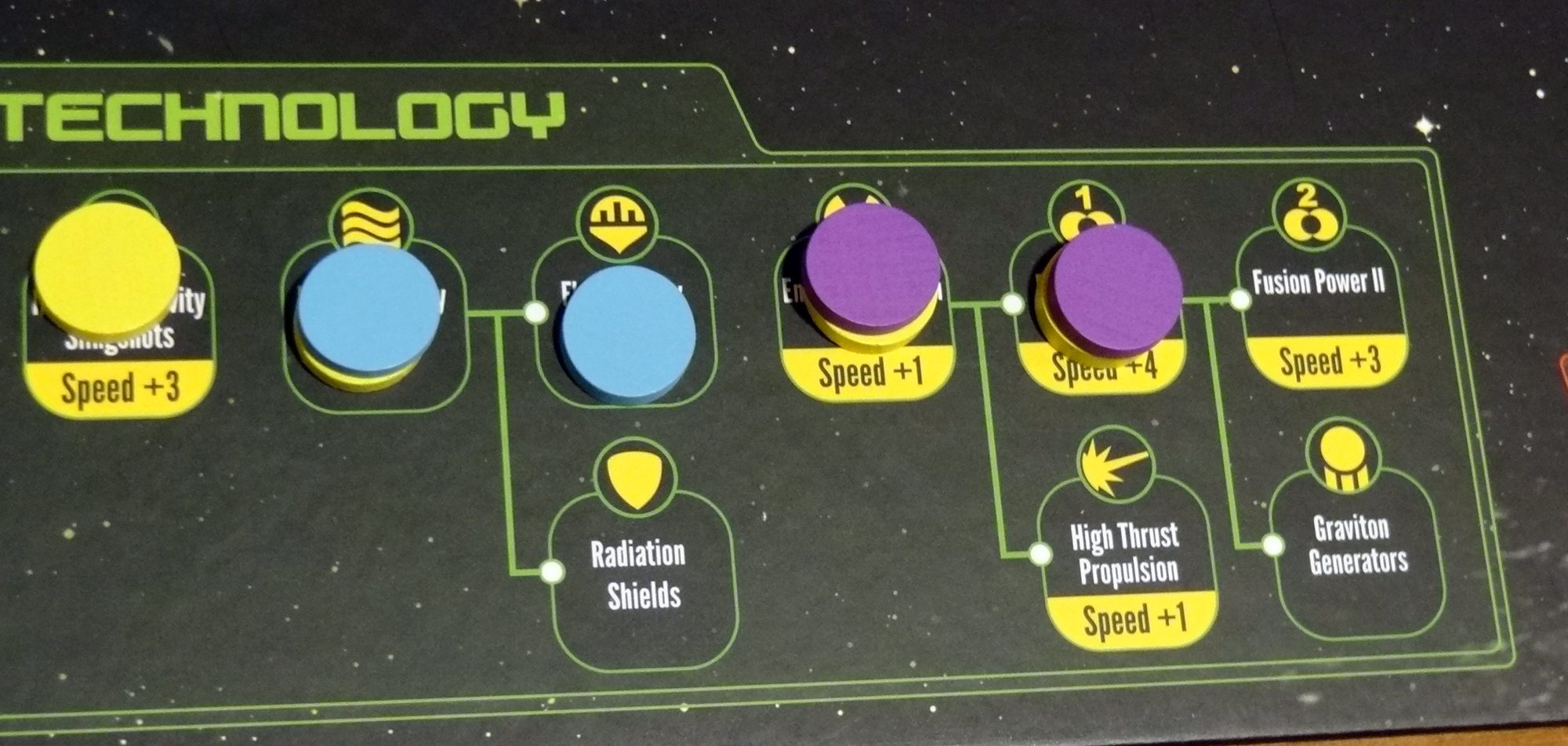
But building in space isn’t just about the money—you have to have the technology, too. Some technologies just increase your speed to reduce your fuel costs. Some locations, however, require specific technologies before you can build there—for instance, a base on the Lunar Mineral Beds requires High Efficiency Insulation (the wavy lines). If you don’t have access to the tech, you can’t build there. If somebody else already controls the tech, you may pay them 1 credit to buy access to it.
Scoring happens once at the end of each generation, and also whenever somebody plays a Scoring card. Each player gets 1 point per factory and 2 points per colony. You also get points for having the most or second-most Fame. Finally, you get a chance to buy some points if you have a lot of cash sitting around.
Some of the cards have a little exclamation point icon in the corner—if you’re using the optional Event cards, then that icon triggers an event. Draw a card at random and follow its instructions. Most will ask you to draw a random location, and then something happens there—sometimes good, sometimes bad.
The game ends at the end of the fourth generation (with one last scoring round), and then whoever has the highest score wins.
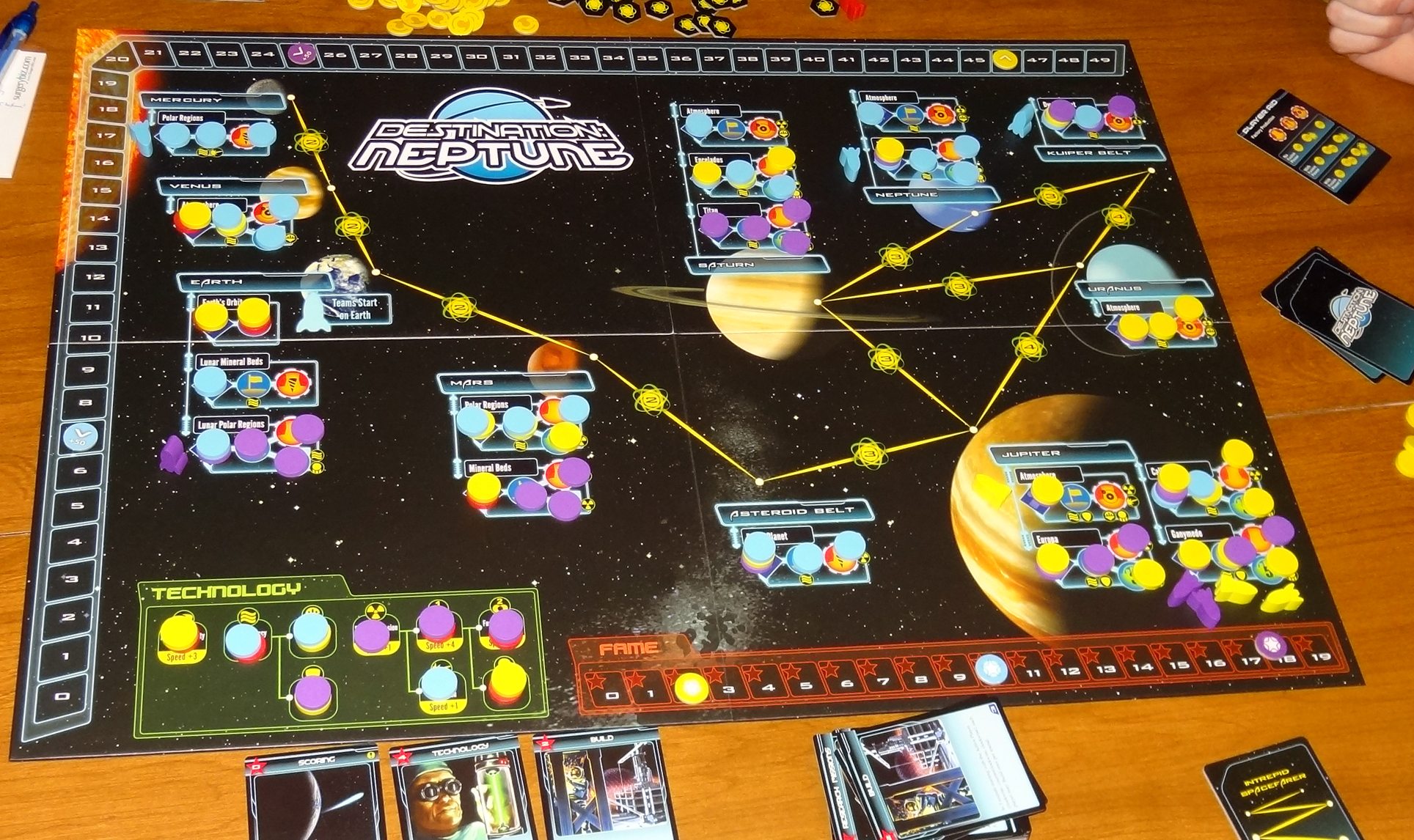
The Verdict
A decade ago this game would have been known as Destination: Pluto. But now nobody wants to go there, because it’s not really a planet. Poor Pluto. But the theme of the game, corporate space exploration, might be pretty accurate. Certainly, as this recent Onion article emphasizes, it is becoming harder and harder for our national space program to get funding.
Of course, that hardly guarantees that you’ll be flush with cash while playing Destination: Neptune. Money can be scarce, and fuel even scarcer. The most painful thing that can happen is when somebody plays a Build card and you don’t have enough money or fuel to take advantage of all three rounds of building. You have to just sit and watch everyone else’s influence creeping a little further out into the solar system while your construction crews sit idle. Plan ahead!
The mechanics in the game remind me of a couple of other games. One is Puerto Rico or Race for the Galaxy—like those games, one player chooses an action, and in most cases all the other players also get some related action or benefit. When you Attract Investors, everyone gets cash, but the person who played the card gets the most. When you play Research Missions, everyone is allowed to buy into existing research missions, but you’re the only one who gets to launch new ones. That means that one important strategy is playing cards at a time when your opponents get the least benefit from them—which is particularly important for Build and Scoring.
That’s one of my favorite things about this game, is deciding which cards to sell, which cards to play, and when to play cards. Do you invest in Technology first (which gives you Fame, might earn you money when other players pay you for access to it), or do you get a head start on building while your opponents are cash-poor? Should you sell this Attract Investors card for only 2 coins so you can take another action, or should you play it as your action to get a lot more money? There are a lot of meaty decisions to make throughout the game, and that’s where Destination: Neptune really shines.
Because of the way economics works, it also reminds me some of Power Grid. You’re constantly calculating how much fuel and money (and technology prerequisites) you’ll need to build at a particular site. When the Fuel Broker card comes up, everyone scrambles to figure out how much fuel they’ll need and whether they can afford to buy it. The problem, though, is that (like Power Grid) the game can get bogged down. I try to strike a balance between time spent calculating and keeping the game moving, but the unfortunate truth is that victory is heavily dependent on how well you budget—which means the longer you spend figuring out exact costs, the better you’ll do … and the longer the game will go. Still, I enjoy this sort of calculation and I know there are gamers who love budgeting under pressure.
The players do have some other control over the speed of the game, too. Each turn, the number of cards you draw depends on whether you sold a card to the Opportunity Track and whether you played a card from your hand or the Opportunity Track. Sell a card and play from your hand, and you’ll draw two cards, shortening the game. Don’t sell a card and play something from the Opportunity Track, and you won’t draw anything—but you’ll also get less money and less Fame.
The game is billed as a 90-minute game, and so far I think mine have been longer than that, but each time it’s been with new players, so I think it would speed up once everyone was familiar with the game. The analysis paralysis problem might still remain, though.
There is an educational, non-fiction element to Destination: Neptune, but it’s somewhat peripheral to the game. If you chose to focus on it with your kids, you could definitely point out why you need particular technologies to build on certain planets. Also, each Location card has a fact about the location; when I played with adults we didn’t read those aloud, but if you wanted to focus on the science you could certainly pause and find out more about various planets that way.
The game feels like it does offer multiple paths to victory, though you definitely need to build something or you’ll be left behind in scoring rounds. I don’t know if accumulating wealth and fame would be enough to keep up with building. There is some luck involved, because if you never draw any Technology cards, then you’ll have to pay cash for access to all the tech, plus you’ll fall even farther behind on the Fame track. Research Mission cards are also really important, because it’s the only way you can establish new research missions, which are required to build at a location.
The flow of the game can feel very different based on what cards are played when. In one game, there was so much building and expansion that we started to run out of tokens. In another, we found that we didn’t establish nearly enough research missions and we soon ran out of eligible locations, with several places that we never reached by the end of the game.
It’s definitely a game that will require multiple plays to find optimal strategies. None of us have really taken advantage of the Factories Produce card, so I get the impression that I must be missing something important.
Overall, I think Destination: Neptune has some great gameplay, but I’m not sure it’s one that quite fits my usual gaming group. It’s just a little longer than I prefer, and I think it’s one that I wouldn’t end up playing enough to really get the hang of it. (Kind of like Power Grid, which I also really like but have only played a handful of times in the past decade.) I like the overall feel of it, but there were little minor design issues here and there that bugged me.
That said, it’s also a good game that’s space-based without really being science-fiction, and if you like games with a lot of economic decision-making, it could be a pretty satisfying, meaty game. I’m definitely curious to see how it feels after playing a couple more times, but with my current schedule that may be a while down the road.
Destination: Neptune will be released this week on June 11. For a list of retailers and online shops that will carry the game, visit the Griggling Games website.
Disclosure: GeekDad received a review copy of this game.

